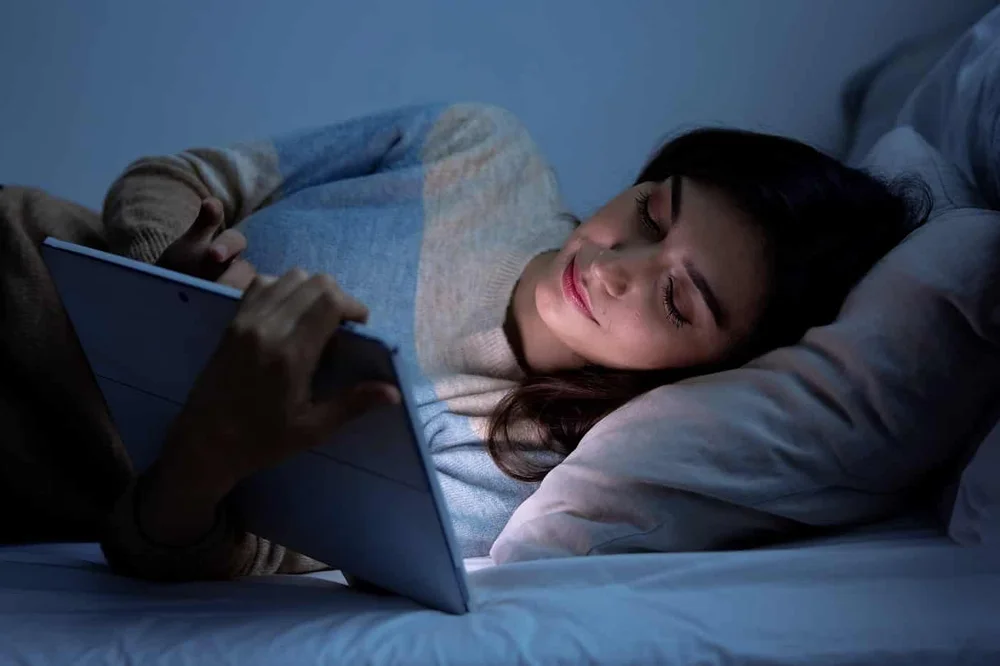What Is Blue Light and How Harmful Is It?
Medically Reviewed by Dr. Nicole Avena
Have you ever found yourself mindlessly scrolling on your phone late at night, unable to tear your eyes away from the mesmerizing glow?
We’ve all been there.
But did you know that this seemingly harmless habit could be putting your health at risk?
In recent years, there’s been increasing concern over the potential negative effects of blue light exposure on our health. Due to modern technology, we’re now being exposed to more blue light than at any previous time. With people spending extensive periods of time in front of screens, understanding the impact of blue light has become a crucial topic.
But what exactly is blue light? And how does it affect our bodies?
Let’s delve into the basics of blue light and its potential risks to your overall health.
What is Blue Light?
Blue light, also known as high-energy visible (HEV) light, is a type of visible light with shorter wavelengths and higher energy levels compared to other colors in the spectrum. It’s found naturally in sunlight and plays an important role in regulating our body’s circadian rhythm or sleep-wake cycle.
Artificial sources of blue light are emitted by electronic devices such as smartphones, computers, laptops, and tablets, as well as LED lights and fluorescent bulbs, which emit varying amounts of blue light. Since prolonged exposure to artificial blue light sources may have damaging effects on your eyes and skin cells, be mindful of these everyday sources of blue light…
8 Common Sources of Blue Light
- Natural Sources
Blue light exposure from natural sources is unavoidable as it’s present in sunlight and the blue sky during the daytime. While this is essential for regulating our body’s circadian rhythm and supporting mood and alertness, excessive exposure can lead to eye strain, headaches, and sleep disruption.
- Electronic Devices
Electronic devices – such as smartphones, laptops, tablets, and televisions – emit high levels of blue light. With the prevalence of technology in our daily lives, we spend more time staring at screens than ever before, increasing our exposure to blue light.
- LED Lighting
LED lights have become popular due to their energy-saving properties. However, these lights emit a significant amount of blue light, which may contribute to eye fatigue and irregular sleep patterns.
- Compact Fluorescent Lights (CFLs)
CFLs are commonly found in households and are considered an energy-efficient alternative to traditional incandescent bulbs. Like LEDs, CFLs emit high levels of blue light that may cause vision and sleep issues.
- Environmental Factors
Certain environmental conditions can increase our exposure to blue light. For example, living in areas where the sunlight is more intense may naturally increase your exposure to blue light.
- Medical Treatments
Some medical treatments, like phototherapy for skin conditions or jaundice, require exposure to intense amounts of blue light for therapeutic purposes. This type of blue light exposure should be carefully monitored and controlled to prevent any potential harm.
- Work Environments
Various work environments – such as offices, schools, and factories – use artificial lighting that can emit varying levels of blue light. Prolonged exposure to these sources of blue light may contribute to eye strain and fatigue.
- Lifestyle Choices
Certain lifestyle choices also can increase your exposure to blue light. For example, smoking has been linked to intraocular pressure (IOP) and may lead to eye strain and other vision problems.
Here Are the Top 5 Health Risks Associated with Blue Light
As technology continues to advance, more people are being exposed to blue light every day. While blue light can have some benefits for our bodies, such as regulating our sleep-wake cycle and improving mood, there are also potential health problems associated with excessive exposure.
Here are some of the main health risks commonly attributed to blue light exposure:

Eye Strain and Fatigue
Excessive exposure to blue light can cause eye strain and fatigue, especially when using devices with screens for extended periods of time. The main reason for this is that the high-energy blue light emitted from these screens isn’t easily filtered by the eye’s natural defenses like other forms of light. Prolonged exposure can lead to muscular discomfort, dry eyes, headaches, blurred vision, and may interfere with your daily routines.
Headaches and Migraines
For individuals who are sensitive to bright lights or suffer from migraines, blue light exposure can trigger or worsen symptoms. This may be due to its direct effect on the brain’s nerve cells and the blood flow response in the brain.
Disruption of Circadian Rhythm
Blue light exposure at night may suppress the production of melatonin – the hormone that regulates our natural sleep-wake cycle. This can affect our ability to fall asleep and may result in poor quality sleep, which can lead to mood problems, irritability, or difficulty concentrating throughout the day.
When our melatonin levels are depleted, it can slow or halt the repair processes that occur during sleep, leading to slower skin healing and regeneration.
Skin Damage
Blue light also has been shown to contribute to skin damage by penetrating deeper into the skin than other forms of light. It can cause oxidative stress, accelerate collagen breakdown, and increase the production of free radicals, which can lead to such signs of premature aging as fine lines, wrinkles, and age spots.
Also, blue light exposure can cause inflammation in the skin. This occurs when the body’s immune response is triggered by certain stimuli like UV rays or toxins from pollution or digital screens. Inflammatory reactions may lead to accelerated aging processes due to their ability to break down collagen and elastin fibers – vital components responsible for maintaining firmness and elasticity in our skin.
Accelerated Aging
One of the lesser-known health risks associated with blue light exposure is accelerated aging. As we age, our eyes begin to lose their natural ability to block harmful UV and blue light rays from reaching our retinas. This makes aging individuals more susceptible to the damaging effects of excessive blue light exposure.
Also, there may be a link between excess blue light exposure and an increased risk for age-related macular degeneration (AMD). The macula is responsible for central vision and prolonged exposure to blue light may damage its cell structures leading to permanent vision impairment.
The good news is that there are several ways to protect yourself from the negative effects of blue light exposure.
Tips for Reducing Blue Light Exposure
- Use a blue light filter or screen protector on all electronic devices.
- Limit screen time at least 1 hour before bedtime. Also, consider using devices that have built-in night mode settings to reduce blue light emissions during nighttime hours.
- Take regular breaks from screens and give your eyes a rest by looking at objects far away.
- Wear glasses with blue light blocking filters for added protection.
- Opt for warmer-toned LED lights instead of cool white ones.
- Incorporate antioxidant-rich foods, such as fruits and vegetables, into your diet to help combat the effects of free radicals on the skin and the rest of the body.
Good Night, Blue Light!
Blue light is an essential part of natural daylight, but excessive exposure to artificial sources can have negative effects on your physical and overall health, especially your eyes, skin, mood, and sleep patterns. By understanding the basics of blue light and taking necessary precautions, you can minimize potential risks and maintain a healthy balance between technology usage and well-being.
If you have additional questions about blue light exposure, be sure to speak with your optometrist or healthcare professional.
At BrainMD, we’re dedicated to providing the highest purity nutrients to improve your physical health and overall well-being. For more information about our full list of brain healthy supplements, please visit us at BrainMD.
These statements have not been evaluated by the FDA. This content is for informational purposes only. It is not meant to substitute for medical or healthcare advice from a physician, nor is it intended to diagnose, treat, cure, or prevent any disease. Consult your healthcare provider before beginning a new health regimen.



